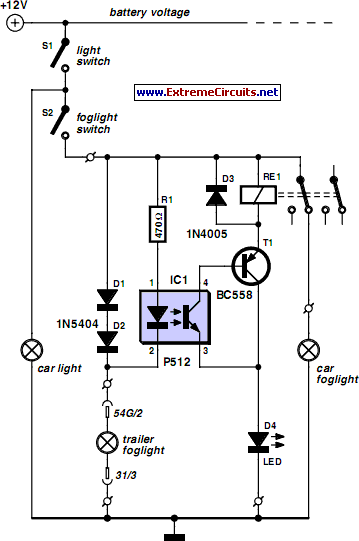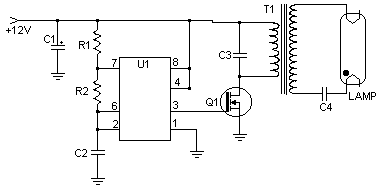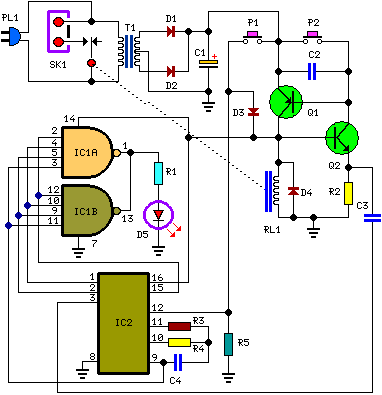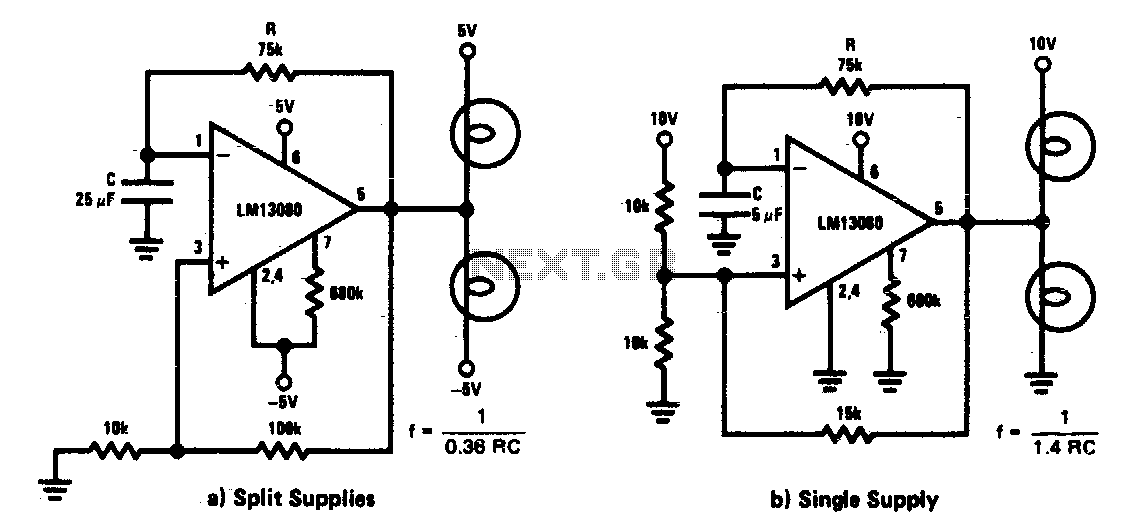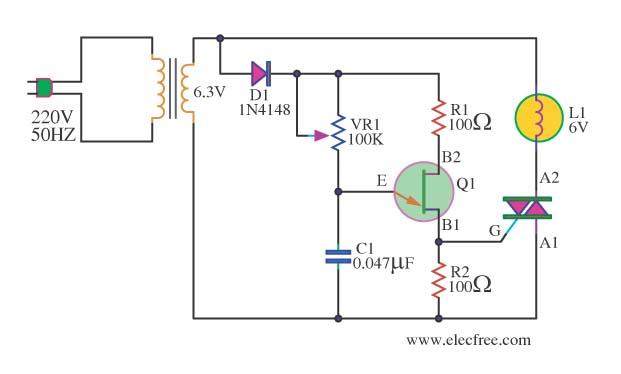
Halogen Lamp Dimmer With Soft Start
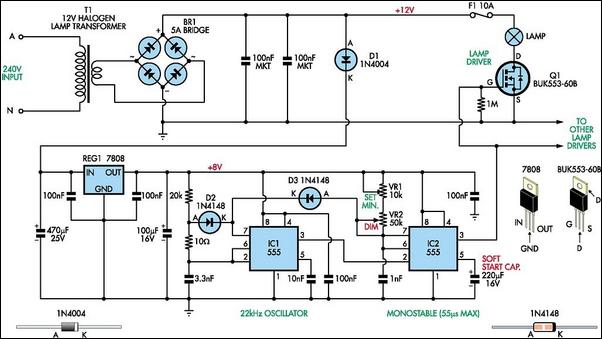
Most dimmers utilize pulse width modulation (PWM) to regulate the power supplied to the lamp. Those that include a switch faceplate manage the firing angle of a Triac on the 240V mains side. While these dimmers work effectively with resistive loads, they may not be suitable for inductive loads such as low-voltage halogen lamp transformers. This circuit also employs PWM, but it operates at a high frequency (22kHz) on the low-voltage side of the lamp transformer. This high frequency simplifies electromagnetic interference (EMI) filtering. Additionally, since this circuit is isolated from the mains by the transformer, it is relatively safe to construct and install. IC1 is a standard 555 astable oscillator with a high duty cycle, producing a narrow negative-going pulse at its pin 3 output approximately every 45 µs (i.e., the frequency of oscillation is about 22kHz). These pulses trigger IC2, another 555 timer configured as a variable monostable. The output at pin 3 of IC2 is normally low, which means that its internal discharge transistor is active, and the 1nF capacitor on pins 6 and 7 is discharged. However, when the monostable is triggered (by IC1), its output goes high, the internal discharge transistor turns off, and the 1nF capacitor charges through VR1 and VR2 until it reaches 2/3Vcc. At this point, the output at pin 3 switches low again. Each time pin 3 of IC2 goes high, it activates power MOSFET transistor Q1, which subsequently turns on the lamp. Potentiometer VR2 is used to control the time it takes for the 1nF capacitor to charge to the threshold voltage, thereby setting the width of the output pulses. At maximum resistance, the pulse width is 55ms, which exceeds the 45ms period of oscillator IC1, causing IC2's pin 3 output to be high for 100% of the time, resulting in maximum lamp brightness. Conversely, if the monostable's period is shorter than that of the astable, each time IC1's pin 3 output goes low, pin 7 of IC1 also goes low, discharging IC2's 1nF timing capacitor via D3. This action retriggers the monostable, causing IC2 to be triggered at a 22kHz rate and producing variable-width pulses based on the setting of VR2, which in turn modulates Q1 to control lamp brightness. D2 isolates IC1's timing circuitry from IC2's. VR1 is employed to set the minimum lamp brightness when VR2 is at its minimum resistance. If this control is unnecessary, VR1 can be substituted with a 1.8kΩ resistor. The 220 µF capacitor on pin 5 of IC2 provides a soft-start function to extend lamp life. When power is initially applied, the 220 µF capacitor is discharged, lowering the threshold voltage (normally 2/3Vcc) and resulting in shorter output pulses. As the 220 µF capacitor charges, the threshold voltage gradually increases until the circuit operates normally. For the prototype, Q1 was a BUK553-60A, rated at 60V, 20A, and 75W. Q1's maximum on-state resistance is 0.1Ω, so switching a 4A lamp load results in a maximum power dissipation of 1.6W. The bridge rectifier dissipates around 5W, thus both components should be mounted on appropriate heatsinks. Power dissipation in the bridge rectifier can be minimized by using power Schottky diodes rated at 5A or greater. The output of 555 timer IC2 can directly drive multiple MOSFETs (up to four in tests). It is important to note that if the MOSFET is positioned far from the 555 timer, buffering will be necessary. Power for the control circuitry is supplied by a 3-terminal regulator (REG1), which produces an 8V rail fed from the output of the bridge rectifier via diode D1.
This circuit description outlines a PWM-based dimmer design that effectively manages lamp brightness while addressing the limitations of traditional dimmers, particularly with respect to inductive loads. The use of high-frequency PWM not only enhances performance but also ensures safety through isolation from mains voltage. The dual 555 timer configuration allows for precise control over the timing and output pulses, making it suitable for various applications where adjustable brightness is required. The inclusion of a soft-start feature further contributes to the longevity of the lamp, while the choice of components ensures efficient operation under varying load conditions. Overall, this design exemplifies a robust approach to modern dimming solutions in electronic lighting systems.Most dimmers use pulse width modulation (PWM) to control the amount of power that is delivered to the lamp. Those that come bundled with a switch faceplate control the firing angle of a Triac on the 240V mains side.
These work fine with resistive loads but may not be suitable for inductive loads such as low-voltage halogen lamp transformers. Thiscircuit also employs PWM but it switches at a high frequency (22kHz) on the low-voltage side of the lamp transformer. This high frequency also simplifies EMI filtering. Furthermore, because this circuit is isolated from the mains by the transformer, it is relatively safe to build and install.
IC1 is a standard 555 astable oscillator with a high duty cycle. It produces a narrow negative-going pulse at its pin 3 output approximately every 45 µs (ie, the frequency of oscillation is about 22kHz). These pulses trigger IC2, another 555 timer, this time wired as a variable monostable. IC2`s pin 3 output is normally low which means that its internal discharge transistor is on and the 1nF capacitor on pins 6 & 7 is discharged.
However, when the monostable is triggered (by IC1), its output goes high, the internal discharge transistor turns off and the 1nF capacitor charges via VR1 & VR2 until it reaches 2/3Vcc. At this point, the output at pin 3 switches low again. Each time pin 3 of IC2 goes high, it turns on power Mosfet transistor Q1 which in turn switches on the lamp.
Potentiometer VR2 is used to control the time it takes the 1nF capacitor to charge to the threshold voltage and thus sets the width of the output pulses. At maximum resistance, the pulse width is 55ms. This is longer that the 45ms period of oscillator IC1, and so IC2`s pin 3 output is high for 100% of the time and the lamp operates with maximum brightness.
Now consider what happens if the monostable`s period is shorter than the astable`s. In this case, each time IC1`s pin 3 output goes low, pin 7 of IC1 also goes low and discharges IC2`s 1nF timing capacitor via D3. This retriggers the monostable. As a result, IC2 is triggered at a 22kHz rate and produces variable width pulses depending on the setting of VR2.
It`s output in turn pulses Q1 to control the lamp brightness. D2 isolates IC1`s timing circuitry from IC2`s. VR1 is used to set the minimum lamp brightness when VR2 is at minimum resistance. If this control is not required, VR1 can be replaced with a 1. 8kO resistor. The 220 µF capacitor on pin 5 of IC2 provides a soft-start facility to prolong lamp life. Initially, when power is first applied, the 220 µF capacitor is discharged and this lowers the threshold voltage (which is normally 2/3Vcc). That in turn results in shorter pulses at the output. As the 220 µF capacitor charges, the threshold voltage gradually increases until the circuit operates "normally".
For the prototype, Q1 was a BUK553-60A, rated at 60V, 20A & 75W. Q1`s maximum on-state resistance is 0. 1O, so switching a 4A lamp load results in a maximum power dissipation of 1. 6W. The bridge rectifier comes in at around 5W and so both should be mounted on suitable heatsinks. The power dissipation in the bridge rectifier can be reduced by using power Schottky diodes rated at 5A or more. The output of 555 timer IC2 is capable of directly driving several Mosfets (up to four in tests). Note, that if the Mosfet is going to be some distance from the 555, it will be necessary to buffer it.
Power for the control circuitry is derived from 3-terminal regulator REG1 which produces an 8V rail. This in turn is fed from the output of the bridge rectifier via diode D1 🔗 External reference
This circuit description outlines a PWM-based dimmer design that effectively manages lamp brightness while addressing the limitations of traditional dimmers, particularly with respect to inductive loads. The use of high-frequency PWM not only enhances performance but also ensures safety through isolation from mains voltage. The dual 555 timer configuration allows for precise control over the timing and output pulses, making it suitable for various applications where adjustable brightness is required. The inclusion of a soft-start feature further contributes to the longevity of the lamp, while the choice of components ensures efficient operation under varying load conditions. Overall, this design exemplifies a robust approach to modern dimming solutions in electronic lighting systems.Most dimmers use pulse width modulation (PWM) to control the amount of power that is delivered to the lamp. Those that come bundled with a switch faceplate control the firing angle of a Triac on the 240V mains side.
These work fine with resistive loads but may not be suitable for inductive loads such as low-voltage halogen lamp transformers. Thiscircuit also employs PWM but it switches at a high frequency (22kHz) on the low-voltage side of the lamp transformer. This high frequency also simplifies EMI filtering. Furthermore, because this circuit is isolated from the mains by the transformer, it is relatively safe to build and install.
IC1 is a standard 555 astable oscillator with a high duty cycle. It produces a narrow negative-going pulse at its pin 3 output approximately every 45 µs (ie, the frequency of oscillation is about 22kHz). These pulses trigger IC2, another 555 timer, this time wired as a variable monostable. IC2`s pin 3 output is normally low which means that its internal discharge transistor is on and the 1nF capacitor on pins 6 & 7 is discharged.
However, when the monostable is triggered (by IC1), its output goes high, the internal discharge transistor turns off and the 1nF capacitor charges via VR1 & VR2 until it reaches 2/3Vcc. At this point, the output at pin 3 switches low again. Each time pin 3 of IC2 goes high, it turns on power Mosfet transistor Q1 which in turn switches on the lamp.
Potentiometer VR2 is used to control the time it takes the 1nF capacitor to charge to the threshold voltage and thus sets the width of the output pulses. At maximum resistance, the pulse width is 55ms. This is longer that the 45ms period of oscillator IC1, and so IC2`s pin 3 output is high for 100% of the time and the lamp operates with maximum brightness.
Now consider what happens if the monostable`s period is shorter than the astable`s. In this case, each time IC1`s pin 3 output goes low, pin 7 of IC1 also goes low and discharges IC2`s 1nF timing capacitor via D3. This retriggers the monostable. As a result, IC2 is triggered at a 22kHz rate and produces variable width pulses depending on the setting of VR2.
It`s output in turn pulses Q1 to control the lamp brightness. D2 isolates IC1`s timing circuitry from IC2`s. VR1 is used to set the minimum lamp brightness when VR2 is at minimum resistance. If this control is not required, VR1 can be replaced with a 1. 8kO resistor. The 220 µF capacitor on pin 5 of IC2 provides a soft-start facility to prolong lamp life. Initially, when power is first applied, the 220 µF capacitor is discharged and this lowers the threshold voltage (which is normally 2/3Vcc). That in turn results in shorter pulses at the output. As the 220 µF capacitor charges, the threshold voltage gradually increases until the circuit operates "normally".
For the prototype, Q1 was a BUK553-60A, rated at 60V, 20A & 75W. Q1`s maximum on-state resistance is 0. 1O, so switching a 4A lamp load results in a maximum power dissipation of 1. 6W. The bridge rectifier comes in at around 5W and so both should be mounted on suitable heatsinks. The power dissipation in the bridge rectifier can be reduced by using power Schottky diodes rated at 5A or more. The output of 555 timer IC2 is capable of directly driving several Mosfets (up to four in tests). Note, that if the Mosfet is going to be some distance from the 555, it will be necessary to buffer it.
Power for the control circuitry is derived from 3-terminal regulator REG1 which produces an 8V rail. This in turn is fed from the output of the bridge rectifier via diode D1 🔗 External reference
